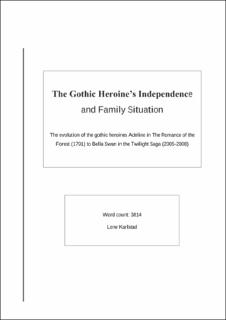| dc.description.abstract | Through close readings of the two gothic stories, I have found both similarities and great differences in the two heroines. Moers sees Radcliffe as one of the pioneers of female gothic, and therefore Adeline can be seen as a model for how a gothic heroine is or should be. I can agree with Moers in that Radcliffe created a mold for the gothic heroine, but that mold is not necessarily as suitable today as it was in 1791 when The Romance of the Forest first was published. In the 1700’s a woman was expected to marry and become a mother, and not until then was she accomplished. Through this sentiment I can see Bella fitting the mold, since she does not reach her full potential until she is married to Edward, turned into a vampire and a mother. In this sense Bella fits the patriarchal and old-fashion mold of gothic heroines. However, I do believe current times calls for a more progressive heroine. Even though Bella stumbles upon misfortunes and in the need of Edwards protection and saving I still consider her as progressive. Bella is decisive and strong willed, and she shows masculine features as well as feminine. At the end of the fourth book, Bella is now a vampire with supernatural abilities of projecting a protective shield over those close to her. She is physically strong and mentally able to overpower the villains on behalf of herself and her family. The final book ends in a big fight between the good side and the bad side, and eventually Bella’s protective shield is what ends up giving the good side the upper hand resulting in them winning and getting their happy ending. In the final chapter Edward retells the final fight and says: “So it was a combination of things there at the end, but what it really boiled down to was … Bella” (2010, p. 688). Moers who is considered a feminist might appreciate Bella’s ability to be the hero who saved them all at the end of the story, rather than the heroine who after many misfortunes happens to get a happy ending because of actions done by male characters.
This paper has focused on the evolvement of the gothic heroine by looking at Ann Radcliffe’s heroine from The Romance of the Forest (2009), Adeline, and comparing her to Bella, the heroine of Stephanie Meyers Twilight Saga (2007, 2010). Critics, like Ellen Moers (1976), have seen Radcliffe as the originator of the female gothic and gothic heroines. Typical characterizations of Radcliffe’s heroine, Adeline, is her dependency on others, her involvement in misfortunes, her frequent weeping, and her accomplishment of getting a happy ending after all. Jamie T. Corson (2010) criticizes Moers fascination of Radcliffe’s heroines arguing that the evolution through time requires an evolved gothic heroine as well. Corson contrasts Radcliffe’s heroines with Meyer’s heroine, Bella. Bella is similar to Adeline in the way that they are both dependent on others to some degree, and Bella also finds herself in some unfortunate events and accidents where she is saved by the male protagonist. The difference between Adeline and Bella, however, is remarkable. Bella is more progressive and feminist in her ability to speak her mind and to make decisions contrary to what her ‘protectors’ want her to do. She shows signs of a typical gothic heroine through her dependency and engrossment in Edward, but she is also a strong individual who ends up protecting her family who at the beginning were way more powerful than herself. | |
